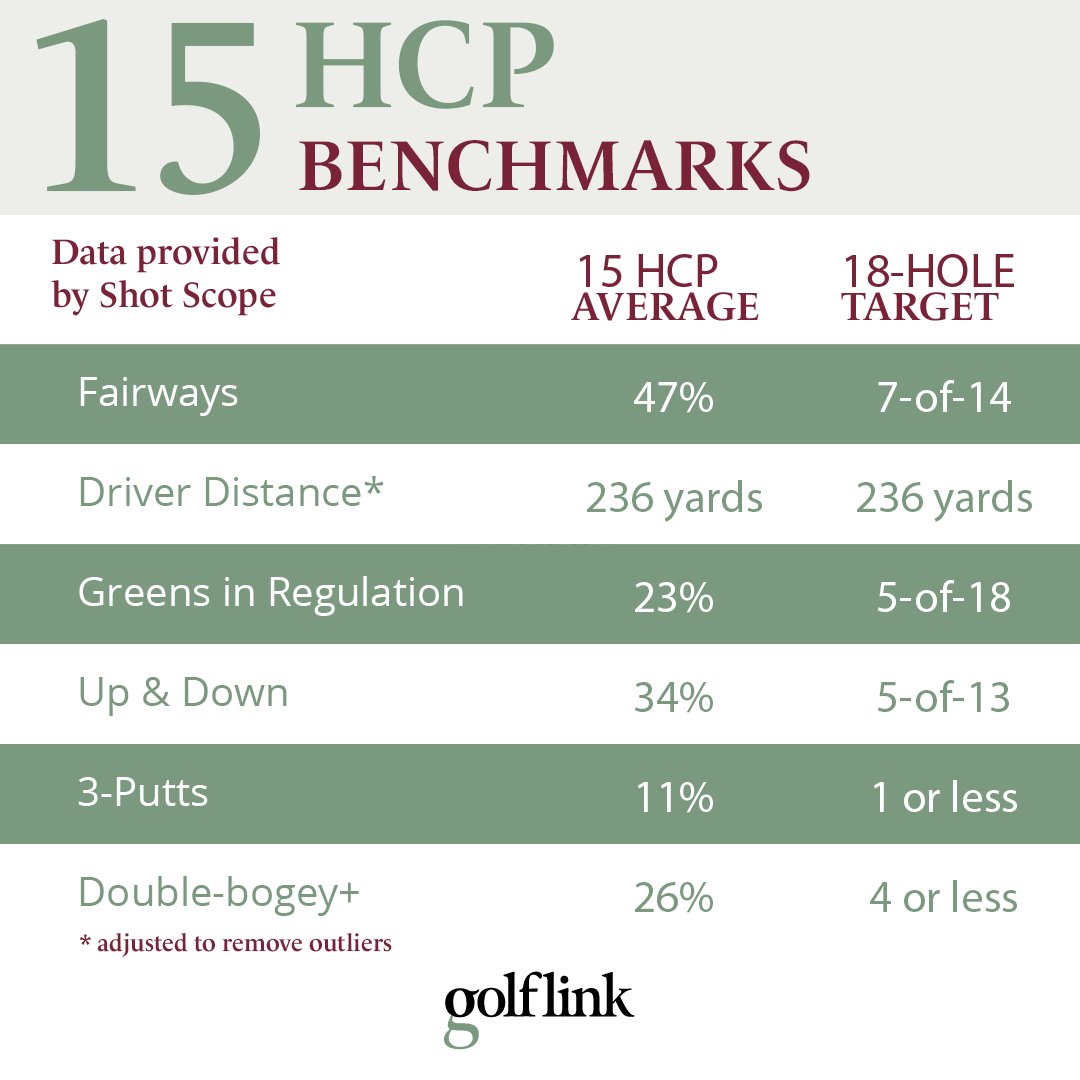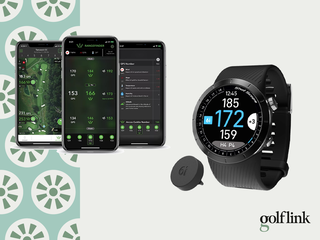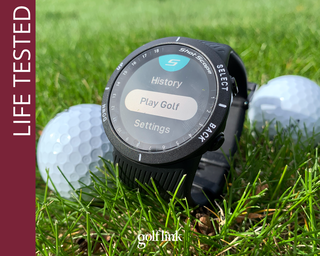Statistics and Strategies for Breaking 90 in Golf
Only 26% of golfers break 90. These are their statistics and the strategies you can use to break 90.

Breaking 90 is a huge milestone in your golf journey. In fact, the National Golf Foundation has calculated that only 26% of golfers break 90 regularly.
In this article, I will explore the differences between golfers who can break 90 and those who have yet to achieve that milestone. I will analyze statistics collected from Shot Scope to break down the characteristics of the average 15-handicapper or sub-90 scorer.
According to Shot Scope data, 15-handicap players average 18.41 strokes over par, which is just over 90 on a par-72 course, and breaking 90 on a par 71 or 70 course. On an above-average day, 15-handicappers are breaking 90, which makes them the ideal statistical benchmark for players looking to break 90.
After breaking down the statistics, I will give you my professional advice on how to break through this awesome milestone and start breaking 90 regularly.
6 Strategies to Help You Break 90
Before we dive into the statistics and the strategies in depth, here are six strategies that we’ll discuss in greater detail, backed up by statistics, that will help you break 90.
- The farther you hit the golf ball, the less club you’ll have into greens, and the closer you’ll be to the hole (proven by statistics). If you aren’t already speed training, start speed training.
- Reducing double and triple bogeys is the quickest way to shoot lower scores. Identify what is causing your big numbers, and attack that issue.
- Optimize your strategy off the tee and don’t assume that pulling less than driver will lead to better accuracy or better scores.
- Hit your approach shots closer to the hole by playing to a yardage closer to the back of the green. You’ll save way more shots with an improved proximity than you’ll lose with the occasional ball over the green.
- When you can use your putter from off the green instead of a wedge, do it. You’ll get much closer to the hole and get up-and-down way more often
- Improve your putting from 12-feet and in. Sinking more of these putts will make a big dent in getting your scores into the 80s.
Benchmark Stats For Breaking 90

Check out the stats of a 15-handicap player who breaks 90 with some consistency
Thanks to Shot Scope, the Scottish-based shot tracking, GPS-guided, statistical golf device leader, we have a very clear picture of what the typical golfer who breaks 90 looks like, statistically speaking.
As a user of Shot Scope myself, both personally in my own game and as a coach with my students, I highly endorse the products and the data they provide.
Here are the overall statistics, according to Shot Scope, of a player who regularly breaks 90, alongside the 18-hole benchmarks you should shoot for if you want to break 90.
| Category | 15 HCP Golfer | 18 Hole Target |
| Score vs. Par | +18.41 | +17 |
| Fairway Hit % | 47% | 7-of-14 |
| Green Hit % | 23% | 5-of-18 |
| Up & Down % | 34% | 5-of-13 |
| Putts Per GIR | 2.1 | 2.1 |
| Double-Bogey+ | 26% | 4 or less |
Club Distances of Players Who Break 90
In general terms, the average distance a golfer carries each of their clubs has a direct correlation to the scores they shoot. Basically, the longer they hit each club, the lower they can score.
Not all golfers who can shoot below 90 hit the ball the same distance. There is a wide range on either end of the spectrum of the carry distances sub-90 shooters hit the ball.
Depending on your physical conditions and your body's strength or limitations, you may not pysically be able to hit the ball a long ways, but anybody can gain distance through speed training. If you want to shoot lower scores, speed training is an easy way to guarantee increased club head speed, and more distance, which trickles down to shorter irons into greens.
Generally speaking, the average distance per club of a 15-handicapper looks like this:
|
Club |
*Performance Avg. (15 HCP) |
|
Driver |
236 yards |
|
3 Wood |
215 yards |
|
3 Hybrid |
197 yards |
|
4 Hybrid |
186 yards |
|
5 Iron |
169 yards |
|
6 Iron |
162 yards |
|
7 Iron |
152 yards |
|
8 Iron |
146 yards |
|
9 Iron |
136 yards |
|
PW |
121 yards |
|
GW |
104 yards |
|
SW |
84 yards |
|
LW |
75 yards |
*Performance Average: Shot Scope uses algorithms to remove outlier shot distances (both long and short) to give a true representation of the distance a well-struck golf shot travels.

Golf Speed Training & Why It's Guaranteed to Work
Scoring Breakdown
In terms of scoring, Shot Scope once again provides us with great intel, based on thousands upon thousands of rounds, of what the average scoring looks like for a typical 15-handicapper compared to the 20-handicapper who is working towards breaking 90.
As you can see, it's not more birdies that separates the 80s-shooters from the 90s-shooters, and more pars or fewer bogeys hardly separates the two either. The biggest difference is the number of double-bogey+ that each group makes. If you can find a way to keep those doubles and triples off your scorecard, and turn those into bogeys, you will instantly increase your chances of breaking 90.
|
Score Breakdown |
15 HCP |
20 HCP |
|
Eagles |
0% |
0% |
|
Birdies |
2% |
2% |
|
Pars |
27% |
20% |
|
Bogeys |
45% |
41% |
|
Double Bogeys + |
26% |
37% |
Here's a look at the scoring statistics of the average 15-handicapper on each type of hole.
|
15 HCP |
|
|
Par 3 Avg Score |
3.9 |
|
Par 4 Avg Score |
5.1 |
|
Par 5 Avg Score |
6.0 |
|
Front 9 avg score |
44.8 |
|
Back 9 avg score |
44.8 |
Breaking 90: Performance Off the Tee
Now, let's get into the meat and potatoes of the characteristics of the average 15-handicapper and how they perform in each facet of their game, starting with shots from off the tee.
One of the biggest takeaways from these tee shot statistics is that, generally speaking, when players take less than driver off the tee, they are often less likely to hit the fairway, sacrificing distance and accuracy.
Your stats certainly vary, but this is great evidence that even if you think you are exchanging distance for accuracy when you club down off the tee, you might not actually be gaining accuracy. It’s always good to track your own performance on the course so you can optimize your decision-making.
Here are the tee shot distances of a 15-Handicapper, using Shot Scope's Performance Average (P-Avg) statistic, and how accurate they are with each club they use off the tee.
As an average among all Shot Scope users, the only club that actually performs better than the driver in terms of accuracy off the tee is a 4-hybrid, which results in 1% greater chance of hitting the fairway and leaves misses an average of four yards closer to the fairway. Of course, individual results can vary noticably.
|
Club |
15 HCP P-Avg |
Fairway % | Dist. From Edge of FWY |
|
All Clubs |
234 yards |
47% | 13 yards |
|
Driver |
236 yards |
47% | 13 yards |
|
3 Wood |
224 yards |
46% | 13 yards |
|
3 Hybrid |
219 yards |
45% | 14 yards |
|
4 Hybrid |
225 yards |
48% | 9 yards |
15-handicappers average just better than a bogey – which puts them on track to break 90 – when they put their tee shot in the fairway. Meanwhile, misses into fairway bunkers are the most penal (other than actual penalty strokes).
|
Score vs. Par |
|
|
Fairway Hit % |
0.9 |
|
Left Miss % |
1.1 |
|
Right Miss % |
1.2 |
|
Bunker % |
1.4 |
Breaking 90 Approach Shot Performance
Moving on, we will next examine a 15-handicapper’s stats regarding approach shots. These statistics truly illustrate the differences between those who break 90 do and those who do not.
Compare the likelihood of missing short to missing long. Overall, you’re about 11-times more likely to come up short than you are to miss long on your approach. This is because of a combination of quality-of-strike (when you mis-hit the ball, you’ll likely come up short) and pulling the wrong club.
Even if you’re better than average in this category, it’s almost guaranteed that you’re coming up short way more often than you’re missing long. One quick way to improve your proximity, which will help lead to lower scores, is to club up, or play to a distance more toward the back of the green than the front or middle. Even if you miss a couple more shots long than you’re used to, you’ll notice you come up short a lot less, and your average proximity is much closer to the hole.
| Proximity | Green Hit % | Short % | Long % | |
| All Approaches | 155 ft | 23% | 54% | 5% |
| 50-75y | 42 ft | 54% | 26% | 12% |
| 75-100y | 53 ft | 45% | 29% | 10% |
| 100-125y | 64 ft | 36% | 33% | 9% |
| 125-150y | 79 ft | 28% | 38% | 6% |
| 150-175y | 106 ft | 19% | 48% | 4% |
| 175-200y | 145 ft | 11% | 64% | 3% |
| 200-225y | 208 ft | 5% | 83% | 1% |
It should come as no surprise that the less club you need, the better you will perform, on average. As you move down through the bag, your likelihood of hitting the green, your average proximity, and the average shots needed to finish, all improve.
This doesn’t mean you should hit 8-iron instead of 7-iron from 150 yards, but it is worth factoring in these statistics as you select your strategy off the tee, which will set up your approach distance.
Here are the average approach shot statistics of a 15-handicap player.
|
Club |
Green Hit % |
Proximity |
Shots to Finish |
|
3 Wood |
4% |
261 ft |
4.75 |
|
3 Hybrid |
10% |
198 ft |
4.46 |
|
4 Hybrid |
9% |
173 ft |
4.51 |
|
5 Iron |
10% |
161 ft |
4.39 |
|
6 Iron |
15% |
158 ft |
4.26 |
|
7 Iron |
20% |
147 ft |
4.21 |
|
8 Iron |
27% |
104 ft |
4.01 |
|
9 Iron |
32% |
97 ft |
3.83 |
|
PW |
36% |
81 ft |
3.85 |
|
GW |
42% |
72 ft |
3.61 |
|
SW |
41% |
61 ft |
3.52 |
|
LW |
37% |
60 ft |
3.45 |
Breaking 90: Short Game Performance
Short game shots and putting are areas that really separate one handicap level from the next, or one scoring barrier to the next. As you will see in the stats below, these are some critical areas to work on in order to break through the breaking 90 scoring barrier, or any scoring milestone in golf.
If there's one takeaway from these stats, it's that if you have an opportunity to use your putter from off the green, the statistics show that you’ll finish much closer to the hole, get it up-and-down way more often, and need far fewer strokes to finish than if you pull a wedge or short iron.
If you’re not already pulling your putter when there’s a clear path from your ball to the hole from off the green, then pivoting to this strategy can really help.
Here's a look at the short game performance of a 15-handicap player.
|
Club |
Up & Down % |
Proximity (ft) |
Shots to Finish |
|
8 iron |
30% |
16 ft |
2.68 |
|
9 iron |
27% |
17 ft |
2.74 |
|
PW |
29% |
17 ft |
2.70 |
|
GW |
20% |
21 ft |
2.84 |
|
SW |
17% |
25 ft |
2.82 |
|
LW |
21% |
23 ft |
2.63 |
|
Putter |
71% |
7 ft |
2.13 |
We classify short-game shots as those shots within 50 yards. Here’s how the average 15-handicap player performs on all short-game shots.
|
Up & Down % |
34% |
|
Sand Save % |
18% |
|
Avg Proximity |
18 ft |
|
Shots to Finish |
2.78 |
Breaking 90: Putting Performance
The final area of the game to scrutinize statistically is perhaps one of the most crucial aspects of golf: putting.
This is not just a significant part of the scoring equation in golf, but it's also an area where golfers notoriously neglect to dedicate ample practice time.
Using these stats, however, you can identify the areas where you have the biggest opportunity to align your performance with, or even exceed, that of a player who regularly breaks 90.
Let’s look at those make percentages, for starters. If you can sink more putts inside of 12 feet, you can really make some progress towards breaking 90. For comparison sake, we’ve added the make percentages of an average 20-handicap player, those on the brink of, but not quite, breaking 90.
Here’s an article I wrote recently on how to improve your putting. And if you’re practicing diligently but still struggling to improve in this area, there’s a good chance that a putter fitting could unlock better putting performance for you.

How to Putt in Golf: A Complete Guide From Stance to Speed
Here are the putting statistics of a 15 Handicap player:
|
Putts per round |
32 |
|
Putts per GIR |
2.1 |
|
1 putt % |
29% |
|
2 putt % |
60% |
|
3 putt % |
11% |
|
Avg Holes per 3 putt |
9.7 |
|
First putt distance |
17 ft |
And here are the make percentages, by distance of 15-handicap players who often break 90, compared to those of 20-handicap players who strive to break 90.
|
Distance |
15 HCP |
20 HCP |
|
0-3 ft |
93% |
90% |
|
3-6 ft |
59% |
55% |
|
6-9 ft |
36% |
33% |
|
9-12 ft |
22% |
18% |
|
12-18 ft |
16% |
14% |
|
18-24 ft |
9% |
7% |
|
24-30 ft |
7% |
5% |
|
30 ft + |
2% |
2% |
We all know that if a putt doesn’t reach the hole, it has no chance of going in the hole. The statistics show that a relatively low percentage of putts miss long and finish more than three feet from the hole.
If you can improve your distance control to hit putts with enough speed to finish about one foot past the hole, you’ll see a lot more putts drop into the hole when you start them on a good line, rather than coming up one roll short.
|
Miss Long |
45% |
|
Miss Long Inside 3 ft |
32% |
|
Miss Short |
55% |
|
Miss Short Inside 3 ft |
34% |

Why You Need a Putter Fitting and How to Do It Yourself
Building a 3-Step Plan to Break 90
How your specific stats stack up against a player who breaks 90 regularly will vary, but these baselines can help you figure out where your best opportunities to improve are, and identify your strengths.
From there, you have to ask yourself two key questions:
- How can I identify my own unique statistical targets based on my game?
- How can I create a practice plan tailored to my unique statistics to finally break that 90 barrier?
That is what I will outline for you now in three easy steps.
Step #1 Gather Your Data
Your first step is to track some of your general stats above and evaluate your game to see where you stack up against those benchmarks.
So how do you do this?
Your best bet is to check out Shot Scope, the company from which I got the statistics for this article. Shot Scope has several game and stat-tracking devices. The most basic, Shot Scope CONNEX, is what I use and use with my students.
Once you start tracking, I suggest you track at least five rounds of statistics before evaluating your tendencies and creating a game plan.

Arccos vs. Shot Scope: The Head-to-Head Winner
Step #2 Evaluate Your Data
After collecting your data, you can analyze it to identify areas where you fall short compared to a 15-handicap or a golfer shooting below 90. Sharing this data with a coach can significantly benefit your planning as you aim to break 90.
The areas of your game that you think need improvement might not actually be the ones that require the most immediate attention. A skilled coach can assist you in determining the most effective way forward.

Shot Scope V5 GPS Golf Watch Life-Tested Review
Step #3 Start From the Hole and Then Move Back
While other coaches may hold different views, I am a firm advocate of a strategy that starts from the hole and progresses backwards. This approach, in my experience, has proven to be highly effective in driving significant improvements in your game.
While it's true that tee shot proficiency is important, as the stats show, those areas of the game usually take longer to make significant changes. Focusing on putting, then chipping, pitching, and bunker play is a great way to start to shave strokes the quickest, at least from what I have seen from my 30 years of experience in the game.
Breaking Through
While the strategy I've outlined is effective, it's important to maintain a well-rounded practice plan that covers all aspects of the game.
By analyzing your stats and devising a plan that starts from the hole and progresses backwards, you can make significant strides in improving your overall game. With this approach, breaking 90 consistently is well within your reach!